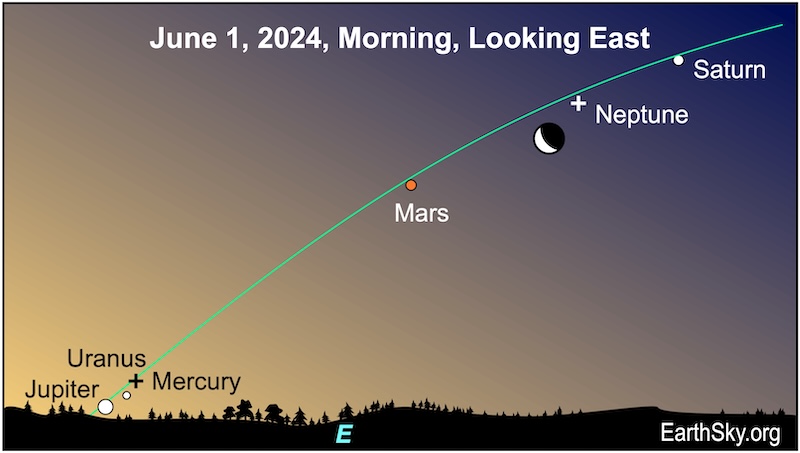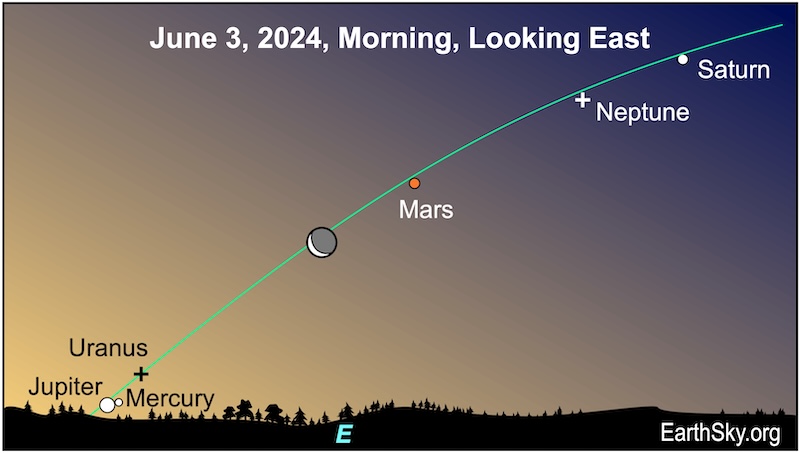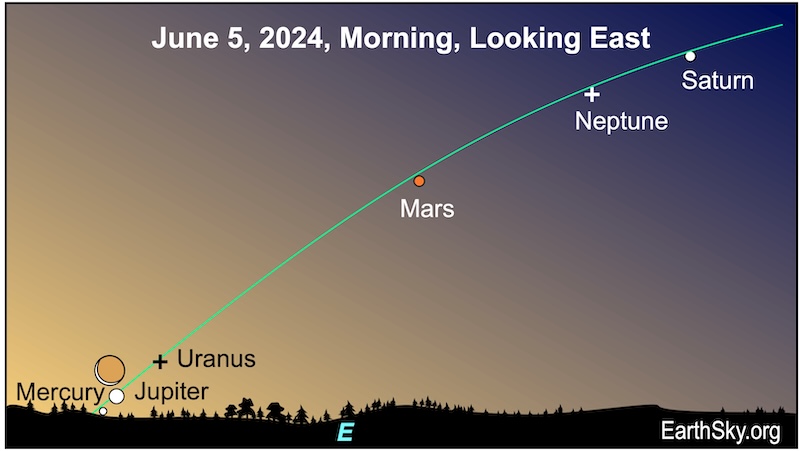Lineup of 6 planets in early June
There are only eight major planets in our solar system. One is the Earth below your feet. One is Venus, currently hidden in the sun’s glare. But this past couple of weeks the internet has been buzzing with the fact that the other six planets – Saturn, Neptune, Mars, Uranus, Mercury and Jupiter – will all grace the eastern sky before sunup in the first days of June. Will you see them? Ummmm …
You’ll easily see two planets! You might see two more with binoculars, assuming you have a very clear and unobstructed sunrise horizon. The other two? It’ll be very tough, if not impossible, to see Uranus so close to the sun. Only experienced observers with telescopes and finder charts will have a shot at seeing Neptune. But Mars and Saturn will be easy to spot. Another two – Mercury and Jupiter – are brighter than Mars or Saturn, although exceedingly low in the sky in the 20 minutes or so before sunrise. So Mercury and Jupiter will be tough, but perhaps not impossible, to spot in the twilight. And – from the Northern Hemisphere at least – you’ll need binoculars to glimpse them.
Now the good news! The moon will pass along this line of planets over the first five mornings of June. The moon can help you find the planets. The best two mornings to look will be June 3 and 4. Then the moon will be below Mars and Saturn, pointing to the place you’ll find Mercury and Jupiter, near the sunrise point as dawn is breaking.

Southern Hemisphere view
Of course, the Southern Hemisphere can see the planets, too. In fact, as so often happens, the Southern Hemisphere has the best view! From the Southern Hemisphere, the planets lie more or less above the sunrise, instead of to one side of it.
Search started at end of May
On May 31, a thick crescent moon was near golden Saturn. On each of the following mornings, you can watch as the moon’s crescent grows slimmer and it drops closer to the horizon, passing the planets in turn.
At the beginning of June, the planets lie, in order from highest to closest to horizon, as follows: Saturn, Neptune, Mars, Uranus, Mercury and Jupiter. To see the trio by the horizon, your best chance is to wait another few mornings when the moon is there to guide you.
Moon will move past the 6 planets
By June 1, the crescent moon is closest to Neptune. Just remember, Neptune requires optical aid and dark skies to spot. It’ll be located about 3 degrees (a bit less than the width of three fingers held at arm’s length) away from the darkened portion of the moon.
On June 2, the crescent moon has drawn closer to reddish Mars. At the same time, Mercury is dropping down toward the horizon and Jupiter, in anticipation of their upcoming conjunction.
On June 3, the moon will be past Mars and Saturn, pointing to Mercury and Jupiter (and Uranus) near the sunrise point.
Mercury and Jupiter will appear closest together in the morning sky on June 4. The two planets will be less than a degree apart. That is, if you held up a pinky at arm’s length, both planets would neatly hide behind it. And that’s if you can find them! While the planets are shining brightly, they’ll be awash in the rising sun’s glow.




Last morning for the lineup of 6 planets
Your last chance to snag all six planets before sunrise is probably on June 5. On that date, Mercury will be dropping fast toward the horizon. Jupiter will be higher up, and the whisper-thin crescent moon (at just 1.7% lit!) will hover above the planetary pair. Soon, Mercury will be too close to the sun to see. However, Jupiter will be moving higher out of the sunrise’s glow.

Why are the planets in a line?
It’s not a coincidence that these worlds – Mercury, Mars, Jupiter, Saturn, Uranus, Neptune and the moon – all lie along a line in Earth’s sky. Our solar system arose from a vast cloud of gas and dust, spinning around our newly forming sun. Now, billions of years later, the major planets and many of their moons lie (more or less) in what’s called the ecliptic, or Earth-sun plane. It’s in this flat plane around our sun that all the major planets and most moons have their orbits. So – looking edgewise into this plane from Earth – we always see them located along a line across our sky.
Normally the planets are spread out, with some in the morning sky and some in the evening sky. But for a handful of days in June, they lie clustered across a relatively small stretch of morning sky, from the east-northeastern horizon toward the southeast, as seen from the Northern Hemisphere.
Watch a discussion about what you can see
Here’s a recording of the livestream where Kelly Kizer Whitt and Marcy Curran discussed what your chances are of seeing all six planets.
Bottom line: There’s a lineup of six planets in the morning sky in early June. Will you see all of them? Find charts and observing tips here.











